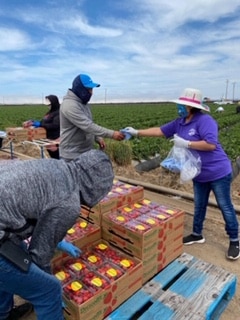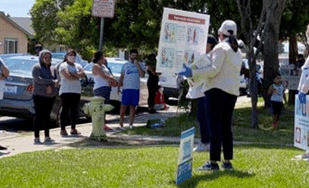Latinx vs Latino/Latina: SBF follows the lead of the subject matter experts, like in this story, who use Latinx to describe the populations they work with. To learn more about the definition please go to lexico.com/definition/latinx.
BY KARA SHOEMAKER
Many things have changed since COVID-19 reached Santa Barbara County in March 2020, but one thing remains constant – whether you are driving from Carpinteria to Goleta, along the 246, or up the 101 towards Santa Maria, farmworkers can be seen out in the fields tending to and harvesting our food. These essential workers, many of whom are migrant Latinx and Indigenous peoples, are the workforce behind our county’s $2.8 billion agricultural industry. They are also disproportionately affected by COVID-19.
As infections peaked in July, nearly 20% of COVID-19 cases in Santa Maria affected farmworkers. When looking closely at the working and living conditions of our county’s essential farmworkers, it is no surprise that COVID-19 is so prevalent among this group. While stay at home orders were issued across California in March, workers in Santa Barbara County and throughout the state continued to work in the fields, often shoulder to shoulder and without face masks or adequate sanitation facilities. Overcrowded and dilapidated housing conditions, lack of COVID-19 information in Spanish or Mixtec, lack of access to health care or health insurance, and low wages are all significant factors that affect the mental and physical health of farmworkers, putting them at greater risk of contracting and spreading the virus.

The Latinx & Indigenous Migrant COVID-19 Response Task Force is working to address these issues and ensure the health and safety of farmworkers in North County. The Task Force was created in March 2020, just as coronavirus reached Santa Barbara County, and is a bi-weekly convening between more than 90 organizations, including the Santa Barbara County Public Health Department and community based organizations like Mixteco/Indigena Community Organizing Project (MICOP) and Central Coast Alliance United for Sustainable Economy (CAUSE).
“According to the Centers for Disease Control and Prevention, long-standing systemic health and social inequities have put many people from racial and ethnic minority groups at increased risk of getting sick and dying from COVID-19,” said Jenny Bruell, Santa Barbara Foundation Community Grants Program Manager. “In fact, in California 61% of all cases associated with COVID-19 are from the Latinx community, but Latinx people only make up 38.9% of the California’s population. The work of the Task Force has been, and will continue to be, critical in helping mitigate the impacts of COVID-19 in our Latinx and Indigenous Migrant communities.”
By meeting every two weeks, organizations on the Task Force are able to discuss the direct concerns and lived experiences of farmworkers in real time and coordinate efforts to create solutions. The Task Force includes three working groups, each focusing on the needs of historically marginalized communities in our county that have been greatly impacted by the pandemic: the farmworkers working group, the mental health and wellness working group, and the Lompoc Prison Task Force.
“Our efforts are grounded in social justice principles and we seek to center the voice and leadership of Latinx and indigenous migrant communities,” said Dr. Melissa Smith, Director of Health Equity Initiatives at UC Santa Barbara and Interim Coordinator for the Task Force. “That’s why this process of creating working groups and having people from these communities and community-based organizations guiding the work is so critical. It’s the opposite of the top down approach, it’s a community based participatory approach.”
In May, the Task Force was awarded a $15,000 COVID-19 Response Grant from the Santa Barbara Foundation as part of the COVID-19 Joint Response Effort for Santa Barbara County.
“The COVID-19 Joint Response Effort provided wonderful and critically needed support to the Task Force so we could jump-start this work,” shared Dr. Smith. “Being able to do that in a proactive way was very important. This was forward thinking of that group to be able to do that.”
One success of the Task Force was the creation of free COVID-19 related services in Santa Barbara County. Community based organizations working with farmworkers could reassure them that they could access all public health department services at no cost and with no concern about their documentation status. Even with deportation fears set aside, farmworkers were often reluctant to get tested because of the fear that it could cost them their livelihoods.

Another challenge farmworkers face is the lack of resources and information. At the beginning of the pandemic, most information was only provided in English with few resources in Spanish and virtually nothing provided in the indigenous languages of the farmworkers. To make matters more challenging, there is no word for virus in Mixtec, and many indigenous languages are completely oral with no written language. To overcome these challenges, the Task Force partners have been working to provide information through a series of culturally appropriate radio campaigns, videos, and PSAs in Spanish and multiple indigenous languages, as well as providing large low-literacy educational boards to get basic information to people in these communities .
Additionally, the Task Force partners are working with small- and large-scale growers and the Santa Barbara Agriculture Commissioner to ensure farmworkers have access to toilets and hand-washing stations and better shade so people don’t have to huddle together. They have also helped to distribute critical PPE and other safety supplies to those in need. Most importantly, the collaborative nature of the Task Force ensures that agencies across the county are working in tandem to address the most pressing needs as they arise .
“We are fortunate to be working with so many organizations who are on the ground with farmworkers, who know the situation, and can help us link with the Public Health Department and Agriculture Commission to create policy changes to help protect the farmworkers – at home and in the field – and help flatten the curve for that community,” said Dr. Smith.
“This Task Force is important and the longer COVID-19 goes on the more important these partnerships are – for-profit sector like growers, nonprofit sectors like us, public health, the government – we are all going to need to continue communicating with one another and participate and bounce ideas off one another to best serve the community,” said Flores-Haro. “At the end of the day all of us are trying to serve and work with the same community. We all need to be on the same page – and it’s this multipronged approach that I think will help keep our families safe as we are going through the motions of COVID.”
Latinx & Indigenous Migrant COVID-19 Response Task Force members:
Blue Sky Center
Bonfire Media Collective
Dignity Health, CA Central Coast Division-North
Cachuma Resource Conservation District
Carpinteria Children’s Project
Catholic Charities
CAUSE
Cen Cal Health
Center for Employment Training
City of Santa Maria
Community Environmental Council
Community Health Centers of The Central Coast
County of Santa Barbara
County of Ventura
Domestic Violence Solutions
DRIVERS LISTOS
Eastern Kentucky University
El Centro
Eyeshine
Family Resource Center
Family Service Agency/Santa Maria Valley Youth & Family Center
First 5 Santa Barbara County
Future Leaders of America
Foodbank of Santa Barbara County
Food & Water Watch
Fund for Santa Barbara
Herencia Indigena
HOPE/ ESPERANZA
Hospice of Santa Barbara
Mi Vida, MI Voz
Immigrant Hope
IMPORTA
Independent Living Resource Center,
Isla Vista Youth Projects
Just Communities
La Casa de la Raza
La Hermandad
Legal Aid Foundation of Santa Barbara County
Latinx and Indigenous migrant COVID-19 Response Task Force
Leading From Within
Lideres Campesinas
LISTOS
Little House by the Park
Love your inmate
McCune Foundation
Mexican Indigenous Language Promotion and Advocacy (MILPA)
Mixteco/Indígena Community Organizing Project
National Association for the Advancement of Colored People
New Covenant Church
Non Profit Research Network
Office of Assemblymember Monique Limon
Office of Congressman Salud Carbajal
Office of Supervisor Das Williams
Office of Supervisor Gregg Hart
Office of Supervisor Joan Hartmann
Office of Supervisor Peter Adam
Office of Supervisor Steve Lavagnino
Pan Asian Network
Physician, Independent researcher
Planned Parenthood Action Fund
Planned Parenthood California Central Coast
Population Health, Cottage Health
Public Square Equity Intern Program
Sansum Diabetes
Sansum Diabetes Research Institute
Santa Barbara Bucket Brigade
Santa Barbara City Fire Dept. OES
Santa Barbara County Promotores Network
Santa Barbara Neighborhood Clinics
Santa Barbara Public Health Department
Santa Maria Health Center
Santa Maria Joint Union High School District
Santa Barbara ACT
Santa Barbara Foundation
Santa Barbara Immigrant Defense
Santa Barbara County Department of Behavioral Wellness
Santa Barbara County Education Office
Santa Barbara Cottage Health
Santa Barbara Response Network
Showing Up for Racial Justice Santa Barbara
The Towbes Foundation
Transition Mental Health Association
U.S. Department of Commerce U.S. Census Bureau
UCSB Admin
UCSB Department of Anthropology
UCSB Center For Publicly Engaged Scholarship Internship
UCSB Chicano/a Studies
UCSB Counseling and Psychological Services
UCSB Dept of Linguistics
UCSB Health Equity Initiatives Hub
Valley of the Flowers United Church of Christ
Voluntary Organizations Active in Disaster
Working for Black Lives